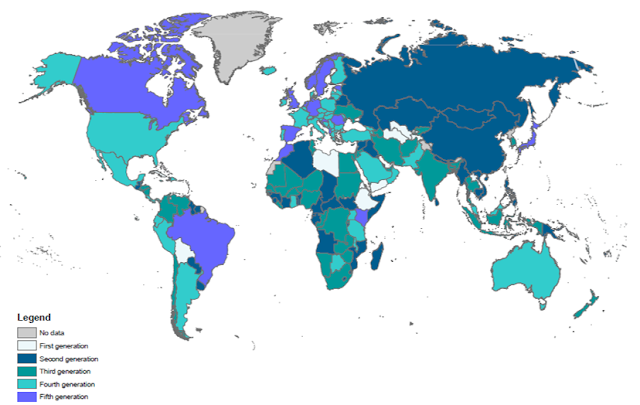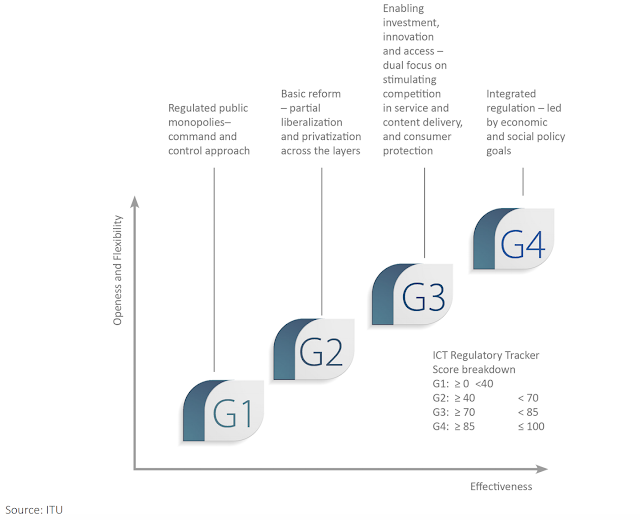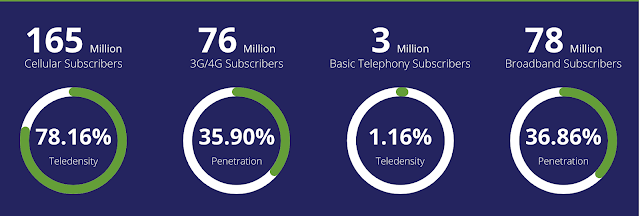PakAlumni Worldwide: The Global Social Network
The Global Social Network
International Telecommunications Union Ranks Pakistan Regulator Among Top 5 in Asia Pacific
International Communications Union has ranked Pakistan Telecommunications Authority (PTA) among top 5 regulators in Asia Pacific region. Pakistan's ICT regulations are 4th generation (G4), more advanced than India's and Bangladesh's 3rd generation (G3) regulations, according to the ITU report titled “Global ICT Regulatory Outlook 2020 (GIRO)”. Only 8% states have managed to achieve G4 status of the 38 economies ranked in Asia-Pacific region. G4 regulations address both economic and social goals. Among the key policy goals are financial inclusion and digital inclusion.
Pakistan's ICT regulations are ranked 4th in Asia Pacific, ahead of Malaysia's ranked 5 but behind Singapore's ranked 1, Japan's ranked 2 and Australia's ranked 3. Pakistan scores 88 and ranks 48th in the world among 193 countries. The report uses 50 indicators organized across four pillars: regulatory authority, regulatory mandate, regulatory regime, competition framework. Pakistan scores 20/20 for regulatory authority, 22/30 for regulatory regime and 27/28 for competition framework and 19/22 for regulatory mandate.
ITU's Definition of 4 Generations of ICT Regulatory Regimes. Source... |
The Global ICT Regulatory Outlook 2020 benchmarks regulatory progress across no fewer than 193 countries worldwide. In three years, the report claims it has established itself as the go-to reference for regulators and policy-makers seeking to shape meaningful, regulatory change that will benefit all.
Pakistan's designation as G4 country and its high rank is in part due to its efforts to use its regulatory powers to close the digital divide. Pakistan's Universal Service Fund (USF) promotes the development of telecommunication services in un-served and under-served areas and populations throughout across the country. The fund consists of contributions (1.5% of adjusted revenues) by the Telecom Operators with no Government funding involved.
Internet traffic in Pakistan has surged 15% amid COVID-19 lockdown, according to Pakistan Telecommunications Authority (PTA). This spike has occurred in spite the fact that Netflix and YouTube have reduced their bandwidth requirements during the current health crisis. Netflix says it has cut its bandwidth use by 25% without sacrificing quality. Google's YouTube video platform has decided to temporarily change the quality of all videos on YouTube to standard definition.The increased traffic is mainly due to people working from homes. Pakistan has nearly 80 million
broadband subscribers as of now.
Related Links:
Pakistan 4G Speed More Than Twice Faster Than India's
Pakistan Digital Advertising Among World's Fastest
Pakistan Internet Traffic Surges Amid Coronavirus Lockdown
Public Sector IT Projects in Pakistan
Pakistan's Gig Economy 4th Largest in the World
Afiniti and Careem: Tech Unicorns Made in Pakistan
Pakistani American Heads Silicon Valley's Top Incubator
Silicon Valley Pakistani-Americans
Digital BRI and 5G in Pakistan
Pakistan's Demographic Dividend
Pakistan EdTech and FinTech Startups
State Bank Targets Fully Digital Economy in Pakistan
Fintech Revolution in Pakistan
The Other 99% of the Pakistan Story
-
Comment by Riaz Haq on May 1, 2020 at 9:38pm
-
China’s Digital Silk Road after the Coronavirus
April 13, 2020
The COVID-19 pandemic will be a history-altering event. But where will it take us? In “On the Horizon,” a new CSIS series, our scholars offer their insights into the fundamental changes we might anticipate for our future social and economic world.
https://www.csis.org/analysis/chinas-digital-silk-road-after-corona...
-----------------------------
Just a few months ago, China’s technology ambitions appeared imperiled by Covid-19, then raging through the center of the country, bringing its economy to a standstill, and wreaking havoc to global supply chains. But the pandemic is already providing new opportunities for China’s rise as a technology power and global provider of digital infrastructure. Indeed, in the months and years ahead, China’s Digital Silk Road will only accelerate and expand.
Consider the China-Pakistan Economic Corridor (CPEC), which Chinese officials have touted as the BRI’s flagship. Since CPEC was announced five years ago, over 60 percent of its projects have been transportation and energy, and many have been bogged down with delays. While proposed pipeline and railway connections between China and Pakistan remain pipedreams, Huawei was able to lay a fiber-optic cable across their border and deep into Pakistan in under two years. Stretching 820 kilometers, the project cost just $44 million—less than it costs to build only four kilometers of railway in Pakistan. Given Pakistan’s mounting debt, the second phase of CPEC, much like the future of the BRI, will place a greater emphasis on smaller, higher-tech projects.
The less visible nature of digital infrastructure also fits more easily into the geopolitical environment that Chinese firms will face as the Covid-19 crisis abates. Prior to the crisis, China’s approach to delivering large projects in foreign countries, which relies heavily on its own companies and workers, stoked resentment among local communities. In recent years, Chinese workers have been attacked in Bangladesh, Kazakhstan, and Kenya, among other stops along the BRI. Given the source of the outbreak, Chinese workers are more likely to face discrimination abroad. Digital infrastructure projects are typically less visible, and less disruptive, to local communities than large transport and energy projects.
Chinese tech companies also see an opening to pitch their products as part of responding to the current outbreak and preventing future pandemics. Hikvision, Dahua, and other leading surveillance companies have introduced thermal imaging systems to detect fevers. Alipay and Tencent have developed health apps that generate QR codes indicating a user’s health status. Naturally, these companies are looking to sell these products overseas. Alibaba is already offering its cloud services to model regional outbreaks and connect health professionals. These offerings are not unique to Chinese companies, but they often come with fewer privacy protections than their Western counterparts.
-
Comment by Riaz Haq on May 8, 2020 at 10:46am
-
elenor signs a contract with USF for High Speed #Internet For Underserved Area in #Pakistan. Contract worth Rs. 588 Million will add #broadband coverage to 500 mauzas in #Sanghar (#Sindh) to serve an area 12,000 sq. km and benefit 1.47 million people. https://www.phoneworld.com.pk/usf-awards-contract-to-telenor-to-pro...
Federal Minister IT& Telecom, Syed Amin ul Haque inaugurated the Next Generation Broadband for Sustainable Development project in Sanghar (Districts of Sanghar and Umerkot) at a ceremony held at Ministry of IT & Telecom on Thursday. The contract was signed by Haaris Manhood Chaudhry, CEO USF and Irfan Wahab Khan, CEO Telenor Pakistan. Secretary IT, Shoaib Ahmad Siddiqui was also present at the ceremony.
Chief Guest of the ceremony, Syed Amin ul Haque stated that under the vision of Digital Pakistan, the Ministry of IT & Telecom is taking concrete steps to spread the benefits of digitalization to the masses. He said that during the spread of Coronavirus, Ministry of IT & Telecom will keep on making efforts to ensure that broadband connectivity helps us overcome this crisis. He added that the key stakeholders in IT & Telecom sector should work together vigorously to come up with innovative ways for fighting against Covid 19 through technology. He congratulated the teams of USF and Telenor Pakistan and also hoped that they will continue to achieve these milestones in future as well.
While sharing his views at the ceremony, Shoaib Ahmad Siddiqui said that the main objective of USF is to facilitate the masses through broadband technology in the country. He added that during the Corona Virus pandemic, Ministry of IT & Telecom is making sure that broadband connectivity plays an integral part in creating ease for people. He further said that USF projects are already making a huge difference in lives of people and with the new challenging scenario during the spread of Corona virus, these projects have become more crucial for socio-economic benefit.
Also speaking at the ceremony, Haaris Mahmood Chaudhry, CEO USF informed that Federal Minister, Syed Amin ul Haque, Secretary IT, Shoaib Ahmad Siddiqui and USF Board of Directors have been giving constant guidance and support to USF for making rapid progress. He also added that all these projects are playing an integral role in enabling people of Pakistan to carry on their activities through broadband technology during the Covid 19 pandemic.
Through the project in Sanghar lot, broadband coverage will be provided in 500 mauzas in Sanghar, covering an approximate unserved area of 12,000 sq. km andbenefitting a population of 1.47 million people.
Sharing his views on the development, Irfan Wahab Khan, CEO Telenor Pakistan said, “We are more committed than ever before to strengthen the pillar of connectivity as part of our purpose of connecting people to what matters most to them. At Telenor Pakistan we are driven to empower the country through enhanced connectivity, creating opportunities and uplifting the lives of millions and stand firm in our commitment to break socio-economic barriers through the use of mobile technology.”
Comment
Twitter Feed
Live Traffic Feed
Sponsored Links
South Asia Investor Review
Investor Information Blog
Haq's Musings
Riaz Haq's Current Affairs Blog
Please Bookmark This Page!
Blog Posts
Pakistan Household Survey HIES 2024-25 Raises More Questions Than It Answers
Recently released HIES 2024-25 household integrated economic survey by Pakistan Bureau of Statistics (PBS) raises more questions than it answers. For example, it shows that Pakistani households are buying lower amounts of basic food ingredients like wheat, meat and eggs in the last four years, implying that people are eating less to cover other expenses, like electricity and gas. But it doesn't explain why the households have reported significantly lower purchases of these items than…
ContinuePosted by Riaz Haq on January 6, 2026 at 5:00pm
Happy New Year 2026: Pakistan's Year 2025 in Review
As we enter the year 2026, it is time to review the year 2025 and wish you all Happy New Year 2026! May it bring peace, prosperity and happiness to all!!
The year 2025 saw Pakistan defeat a brazen Indian attack on its soil, while reviving its economy and…
ContinuePosted by Riaz Haq on December 30, 2025 at 9:30pm — 9 Comments
© 2026 Created by Riaz Haq.
Powered by
![]()




You need to be a member of PakAlumni Worldwide: The Global Social Network to add comments!
Join PakAlumni Worldwide: The Global Social Network